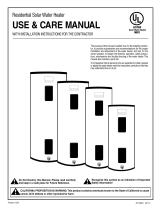
10 49-50336 Rev. 1
Installation Instructions
INSTALLATION INSTRUCTIONS
The location chosen for the water heater must take
into consideration the following:
LOCAL INSTALLATION
REGULATIONS
This water heater must be installed in accordance
with these instructions, local codes, utility codes,
utility company requirements or, in the absence of
local codes, the latest edition of the National Electrical
Code. It is available from some local libraries or
can be purchased from the National Fire Prevention
Association, Batterymarch park, Quincy, MA 02169 as
booklet ANSI/NFPA 70.
POWER REQUIREMENTS
Check the markings on the rating plate of the water
heater to be certain the power supply corresponds
to the water heater requirements. NOTE: 208V
installations may experience lower performance.
LOCATION
The water heater and water lines should be protected
from freezing temperatures and high-corrosive
atmospheres. Do not install the water heater in
outdoor, unprotected areas.
Locate the water heater in a clean dry area as near as
practical to the area of greatest heated water demand.
Long uninsulated hot water lines can waste energy
and water. Unit must be installed in a level location.
If required, add shims under base of unit to level for
proper operation.
NOTE: This unit is designed for any common indoor
installation.
Servicing the water heater requires proper installation
such that front panels can be removed to permit
inspection and servicing. Reference installation
instructions found in this manual.
Moving the water heater or other appliances to provide
service to the water heater is not covered under
warranty.
CAUTION Risk of Property Damage -
The water heater should not be located in an
area where leakage of the tank or connections
will result in damage to the area adjacent to it
or to lower floors of the structure. Where such
areas cannot be avoided, it is recommended
that a suitable catch pan, adequately drained, be
installed under the water heater.
LOCATION (Cont).
Required clearances:
There must be sufficient clearance between any
object and the top, rear and sides of the water
heater in the event service is needed. The controls
and drain at front of unit must have clear access
for operation and service. Installations that require
minimal clearance on the sides or rear of the water
heater for earthquake straps are also acceptable.
In these cases, additional clearance should be
provided on the opposite side of the unit to
allow for service access.
CATCH PAN INSTALLATION
(If required)
NOTE: Auxiliary catch pan MUST conform to local
codes. Catch Pan Kits are available from the store
where the water heater was purchased, a builder
store or any water heater distributor. The catch
pan should be 2” (5.1 cm) minimum larger than the
Water Heater base diameter. To prevent corrosion
and improve Drain Valve access it is recommended
that the water heater be placed on spacers inside
the catch pan.
Relief Valve
Drain Line
Catch Pan
Catch Pan
Drain (piped to
suitable drain)
THERMAL EXPANSION
If a check valve is present on the inlet water line,
it will create a “closed system.” Heating water in
a closed system creates an increase in pressure
within the water system because the pressure is not
able to dissipate in the main supply line. Referred to
as “thermal expansion”, the rapid pressure increase
can cause the relief valve to operate (releasing
water) during each heating cycle, potentially
causing premature failure to the valve or even the
water heater. The suggested method of controlling
thermal expansion is to install an expansion tank in
the cold water line between the water heater and the
check valve as shown in the following illustrations.
Contact your installing contractor, water supplier, or
plumbing inspector for additional information.





